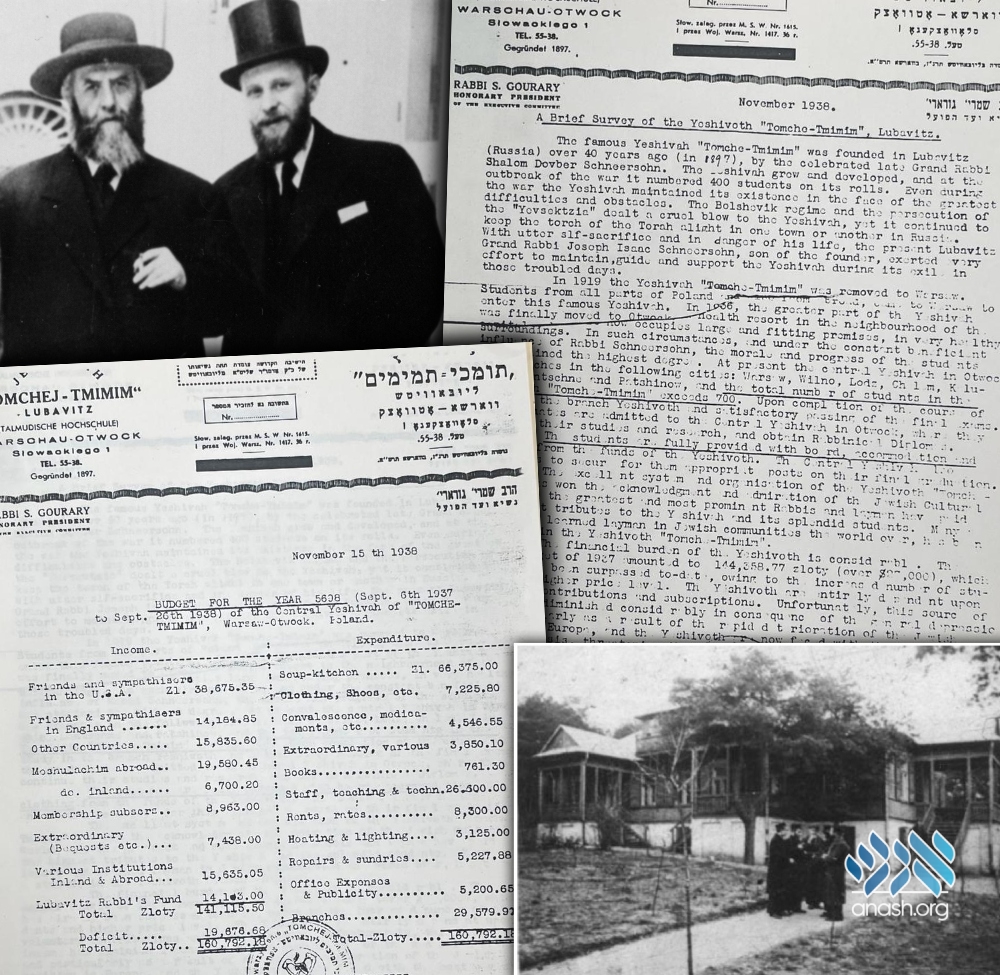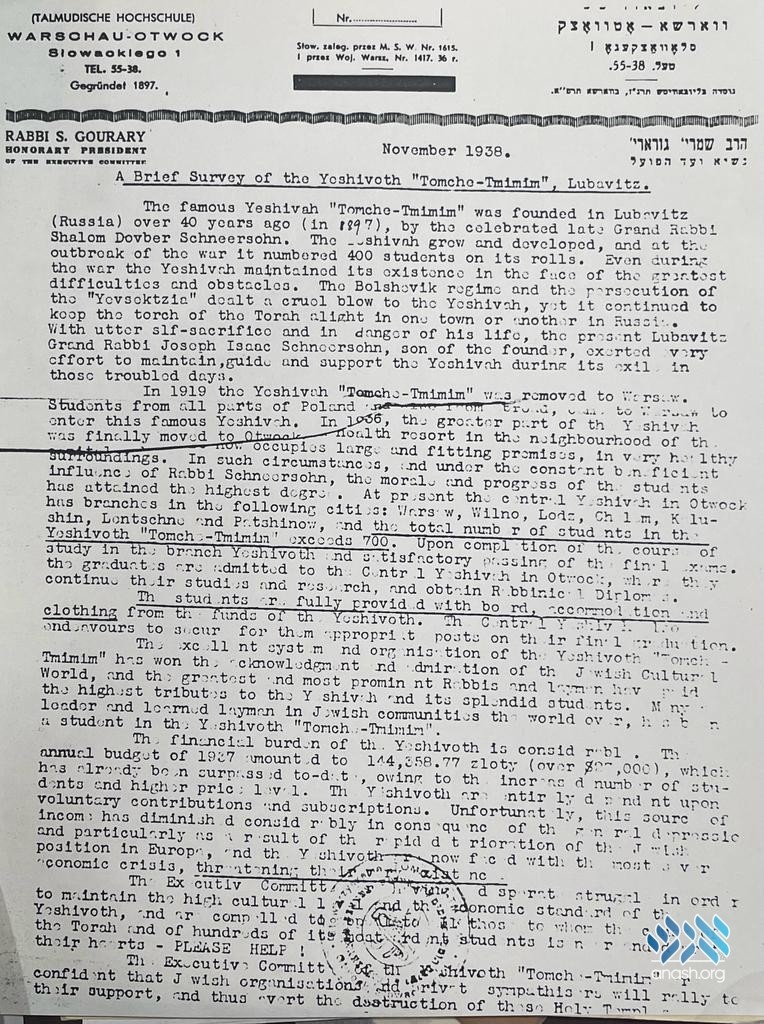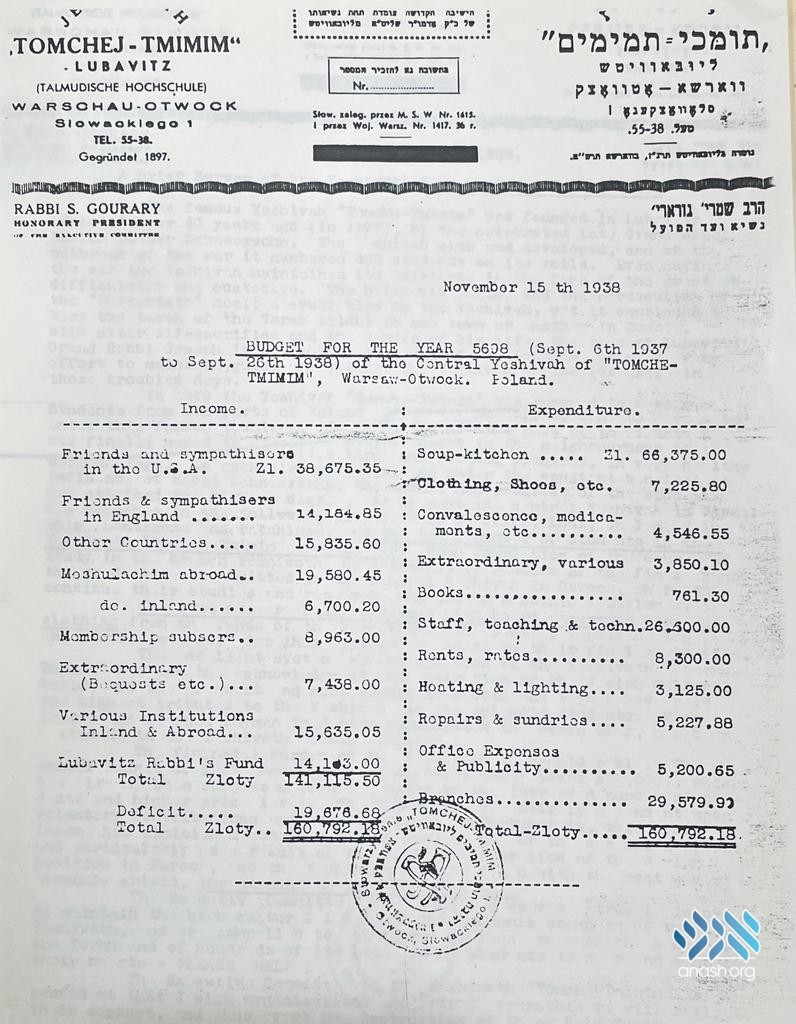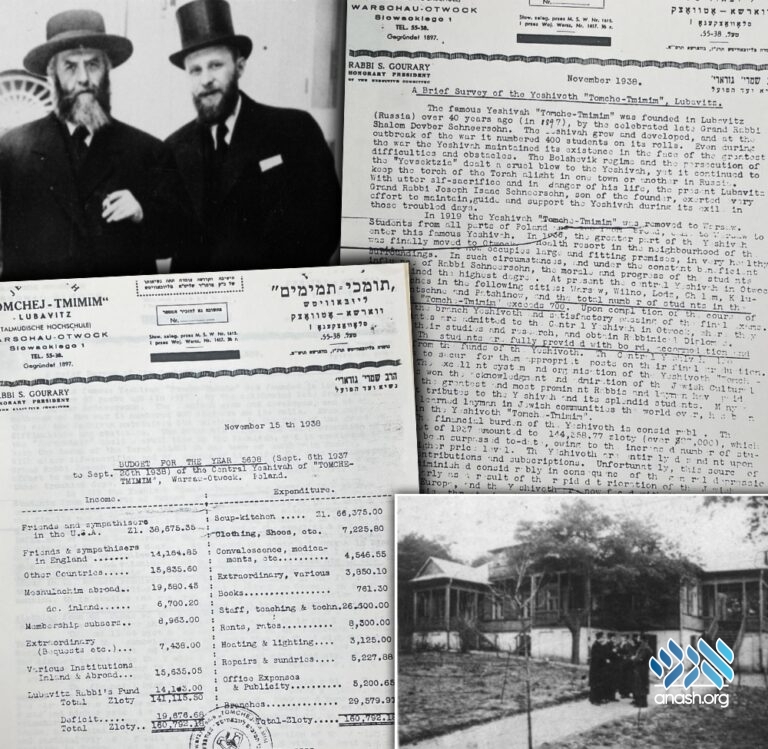ז׳ אלול ה׳תשפ״ג | August 23, 2023
The Budget for Yeshivas Tomchei Tmimim…In 1938
In November of 1938, a short few months before the outbreak of WWII, the Rashag sent an urgent appeal in English to America asking for support of the Yeshiva Tomchei Tmimim network in Poland.

In November of 1938, a short few months before the outbreak of WWII, the Rashag sent an urgent appeal in English to America asking for support of the Yeshiva Tomchei Tmimim network in Poland.
By Anash.org reporter
How much did it cost to run a Yeshiva in 1938?
Among the archives of R’ Meir Harlig, which are being publicized following his passing, are two fascinating letters that give a glimpse into the world of Yeshivas Tomchei Tmimim prior, and during, World War II.
The letters, written in English, were sent by the Rashag, son-in-law of the Frierdiker Rebbe, to supporters and friends in the USA. Rashag held the title of menahel of the Yeshiva, or as translated on the letterhead ‘Honorary President of the Executive Committee.’
Written in November of 1938, the appeals were sent just a few brief months before the Nazi’s invasion of Poland. Yet, antisemitism was already on the rise, and the letter noted the “rapid deterioration of the Jewish position in Europe.”
The second page details the exact expenses of the yeshiva for the proceeding year of 5698 (Sep. 1937 to Sep. 1938), detailing expenses and income in Polish Zloty. The total expenses for the year were 160,792.18 Zloty, which at an exchange rate of 5.31 zl to $1 USD, would translate into $30,281.01 American Dollars. Adjusted for inflation, $30,281.01 in 1938 is equal to $641,950.92 in 2023.
The budget details the expenses for the soup kitchen (66,375 zl – $12,500 USD), for clothing and shoes for the bochurim (7,225.80 zl – $1,360.79 USD), books (761.30 zl – $143.37 USD), staff and teachers (26,500 zl – 4990.58 USD) and more.
Income came in the form of donations from the USA (38,675.35 zl – $7283.49 USD), donations from England (14,184.85 zl – $2671.34 USD), meshulachim abroad (19,580.45 zl – $3738.31 USD), the Frierdiker Rebbe’s fund, and other donations, totaling 141,115.50 Zloty, or $26,575.42 USD.
The remaining deficit was 19,676.68 Zloty, or $3705.58 USD.
Below is reproduced the full text of the letter sent to supporters, which gives a small glimpse at those years when Torah study flourished and Yeshivas Tomchei Tmimim was a beacon of light, which continued to shine, through its students, long after the Nazis forced it to flee overseas.
***
A Brief Survey of the Yeshivoth “Tomche-Tmimim”, Lubavitz.
The famous Yeshivah “Tomche-Tmimim” was founded in Lubavitz (Russia) over 40 years ago (in 1897), by the celebrated late Grand Rabbi Shalom Dovber Schneersohn. The yeshivah grew and developed, and at the outbreak of the war it numbered 400 students on its rolls. Even during the war the Yeshivah maintained its existence in the face of the greatest difficulties and obstacles. The Bolshevik regime and the persecution of the “Yevsektzia” dealt a cruel blow to the Yeshiva, yet it continued to keep the torch of the Torah alight in one town or another in Russia. With utter self-sacrifice and in danger of his life, the present Lubavitz Grand Rabbi Joseph Isaac Schneersohn, son of the founder, exerted every effort to maintain, guide and support the Yeshivah during its exile in those troubled days.
In 1919 the Yeshivah “Tomche-Tmimim” was removed to Warsaw. Students from all parts of Poland … to Warsaw enter this famous Yeshivah. In 1936, the greater part of the Yeshiva was finally moved to Otwock … health resort in the neighborhood of the … now occupies large and fitting promises, in very healthy surroundings. In such circumstances, and under the constant beneficent influence of Rabbi Schneersohn, the morale and progress of the students has attained the highest degree. At present the central Yeshivah in Otwock has branches in the following cities: Warsaw, Wilno, Lodz, Chelm, Kelushin, Lontschne and Patshinow, and the total number of students in the Yeshivoth “Tomche Tmimin exceeds 700. Upon completion of the course of study in the branch Yeshivoth and satisfactory passing of the final exams, the graduates are admitted to the Central Yeshivah in Otwock, where they continue their studies and research, and obtain Rabbinic Diplomas.
The students are fully provided with board, accommodation and clothing from the funds of the Yeshivoth. The Central Yeshivah also endeavours to secure for them appropriate posts on their final graduation.
The excellent system and organisation of the Yeshivoth “Tomche Tmimim” has won the acknowledgment and admiration of the Jewish Cultural World, and the greatest and most prominent Rabbis and laymen have paid the highest tributes to the Yeshivah and its splendid students. Many leader and learned laymen in Jewish communities the world over, have been student in the Yeshivoth “Tomche-Tmimim”.
Th financial burden of the Yeshivoth is considerable. The annual budget of 1937 amounted to 144,358.77 zloty (over $27,000), which: has already ben surpassed to-date, owing to the increased number of students and higher price level. The Yeshivoth are entirely dependent upon voluntary contributions and subscriptions. Unfortunately, this source of income has diminished considerably in consequence of the general depression and particularly as a result of the rapid deterioration of the Jewish position in Europe, and the Yeshivoth are now faced with the most severe economic crisis, threatening their very existence.
The Executive Committee … desperate struggle in order to maintain the high cultural … standard of the Yeshivoth, and are compelled to … those to whom the cause of the Torah and of hundreds of its most ardent students is near and dear to their hearts – PLEASE HELP!
The Executive Committee of the Yeshivoth “Tomche-Tmimim” are confident that Jewish organisations and private sympathisers will rally to their support, and thus prevent the destruction of these Holy Temples.




We appreciate your feedback. If you have any additional information to contribute to this article, it will be added below.